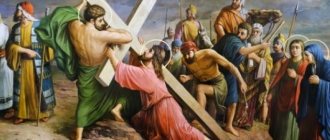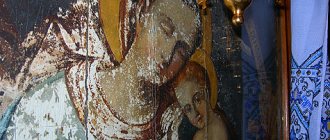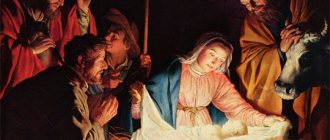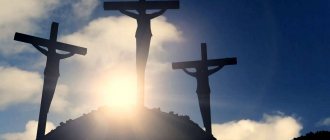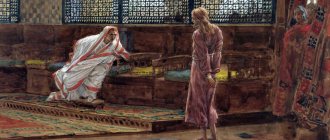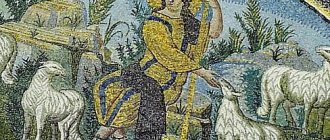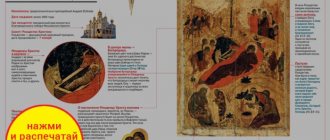The main and main event of the entire Christian world is the resurrection of our Lord Jesus Christ. Without this miracle there would be nothing - neither our salvation, nor eternal life, nor the Christian faith itself. It is the resurrection of the Son of God from the dead that is the basis for the fact that life in paradise can be available to each of us. However, the resurrection of Christ is not the only thing in the Gospel. We know about Lazarus, who was resurrected after 4 days in the grave cave, we know the example of the resurrected daughter of Jairus. The Gospel also testifies to those who rose from their graves after the crucifixion of Christ. So why did the resurrection of Jesus become such a turning point in the entire history of mankind? What does this miracle give us today?
How the Savior was resurrected
All four Gospels describe in sufficient detail the events of the sufferings on the cross, the death of Christ and His subsequent resurrection. So, Jesus died on Friday, at about three o'clock in the afternoon, before the celebration of the Jewish Passover.
Through the death of Christ, man was reconciled with God
One pious and wealthy Israeli, Joseph of Arimathea, received permission from Pilate to remove the body from the Cross and bury Him in a cave. Joseph had his own cave, hewn out of the rock, for his own burial, however, out of great love for Jesus, he decided to bury Him there. The Savior's body was removed from the Cross and anointed with incense, as required by the Jewish funeral traditions of that time. After this, the prepared body was wrapped in clean linen and laid in a cave.
Interesting! The same cloth that was wrapped around the holy body of our Lord Jesus has still been preserved and represents one of the most famous and revered shrines of the entire Christian world - the Shroud of Turin.
Joseph and Nicodemus, who helped him, were part of the Sanhedrin - that was the name of the supreme Jewish court. At the same time, they accepted Christianity and secretly followed the teachings of Christ. Having placed the body of Christ in the cave, they blocked the entrance with a huge stone. Of course, such preparations required much more time, but those who buried Him were in a hurry - the Jewish Passover would begin very soon.
Temples in the name of the Ascension of the Lord
The Feast of the Ascension of the Lord has long been revered in Rus'. Temples were consecrated and monasteries were built in his name. So, in 1407, Princess Evdokia Dmitrievna, the wife of Dmitry Donskoy, founded the Ascension Convent , in which she herself took monastic vows under the name of nun Euphrosyne. After her death, she was buried in the main cathedral of the monastery - Ascension. The temple became the tomb of princely wives and daughters. Among them are the wife of Vasily I Sofia Vitovtovna, the wife of Ivan III Sofia Paleolog, the mother of Ivan the Terrible Elena Glinskaya, the first wife of the formidable Tsar Anastasia Romanovna, Irina Godunova - the wife of Tsar Fyodor Ivanovich and the sister of Boris Godunov. Marfa Ivanovna, the mother of the first sovereign of the Romanov dynasty, Mikhail Fedorovich, and the mother of Peter I, Natalya Kirillovna, were also buried there. After 1917, the monastery was closed and destroyed in 1929. In its place now stands the administrative building of the Kremlin. When the Ascension Monastery was destroyed, the burial places of the princesses and queens were moved to the basements of the Archangel Cathedral.
Ascension Monastery of the Moscow Kremlin. Destroyed 1929
Other Ascension monasteries and churches have survived to this day. In Pskov, two monasteries were dedicated to this holiday: Starovoznesensky , mentioned in chronicles since 1420, and Novovoznesensky , whose main temple was built in 1467.
Starovoznesensky Monastery in Pskov. Church of the Ascension of the Lord (ROC). Modern look
Another famous Church of the Ascension of the Lord was built in 1532 in the village of Kolomenskoye on the Moskva River . This is the first stone tented temple in Rus'. It does not seem very tall, and only from a distance it becomes clear how huge this temple is, built by order of Vasily III in honor of the appearance of the long-awaited son and heir to the throne. It was presumably built by Italian craftsmen.
Church of the Ascension of the Lord in Kolomenskoye, Moscow
In the name of the Ascension of the Lord, the Cathedral of the Ascension Orshin Monastery in the village was consecrated. Orshino, Kalininsky district, Tver region . The Cathedral Church of the Ascension of the Lord was consecrated in 1567 by Saint Barsanuphius of Tver (c. 1495-1576). There were four thrones in it: the main one - the Ascension of the Lord, two side ones - the Venerable Onuphrius the Great and the Holy Great Martyr Catherine, the throne of the Nativity of John the Baptist "on the floors".
Ascension Cathedral of the Orshina Monastery in the Tver region
, the Church of the Snetogorsk Nativity of the Blessed Virgin Mary monastery in Pskov was consecrated . The church was built in 1527-1528 and belonged to the type of bell-tower temples. The central tower rose on a wide base. The top of the building ended with a tent. In the inventory of 1802, the bell tower is listed as a two-story building with cellars; the Church of the Ascension of the Lord is located on the ground floor. There were 13 bells on the belfry. In 1907, during a fire, all the wooden parts of the church-bell tower burned down. The building was restored according to the design of architect Nazimov. In 1932-1934, the bell tower was dismantled for building material. The material used to build the church was a limestone slab with lime mortar. The basement and part of the walls of the first tier of the church have been preserved. In the 1950s, conservation of the ruined remains of the church-bell tower was carried out.
Ruins of the Church of the Ascension in Pskov
In the name of the Ascension of the Lord, the gate church of the Spaso-Prilutsky Monastery in Vologda . The Spassky Cathedral of the Spaso-Prilutsky Monastery, built in 1537-42, is the first stone church not only in the monastery itself, but in all of Vologda. Until 1537, a wooden cathedral of the same name stood on the site of the current Spassky Cathedral. A wooden church in the name of the All-Merciful Savior and the Origin of the Honest Trees of the Life-Giving Cross was erected on the site chosen by him for the establishment of the monastery by the Venerable Demetrius of Prilutsky. When the wooden cathedral burned down, a stone one was built. In the northern wall of the stone fence of the Spaso-Prilutsky Monastery there is the former main entrance to the monastery - the so-called Holy Gate with a small gate church of the Ascension of the Lord, built shortly after the cathedral Spassky Church. Initially, the church was consecrated in the name of the Holy Great Martyr Theodore Stratilates and was called that until the 19th century. In the 18th and early 19th centuries, as a result of fires in the monastery, the church was badly damaged and remained in this condition until 1815, when it was reconsecrated in the name of the Ascension of the Lord. The Ascension Gate Church is very simple in composition and at the same time original. Its cubic volume, modeled on the most ancient gate structures of Rus', is devoid of altar apses, this typical element of a church building. The temple is completed by one light dome, originally installed on two stepped pyramidal tiers of kokoshniks. The kokoshniks did not correspond to the design of the vaults and were decorations that enhanced the slender silhouette of the entire building. During the Soviet years, the monastery was plundered. In the 1930s, the monastery housed a transit prison for dispossessed people who were transported to the northern Gulag camps; in the 1950s-70s, the territory of the former monastery was occupied by military warehouses. Only in 1975-79, the central group of monuments with the adjacent territory, after restoration began in 1954, became a branch of the Vologda State Museum-Reserve. Thanks to the scientific restoration carried out in 1954-1975, monuments of the 16th-17th centuries. the supposed original appearance was returned. Currently, the Spaso-Prilutsky Monastery is active.
Ascension Church of the Spaso-Prilutsky Monastery in Vologda
In the name of the Ascension of the Lord, a church on Nikitskaya Street in Moscow . Initially the temple was wooden, and in 1634 it was rebuilt in stone. The building is distinguished by its volumetric-spatial design and the nature of its decorative design. The facades of the high two-height quadrangle, elongated along the north-south axis, are processed with promising vertical panels, which have analogues in 16th-century architecture. During the XVII-XIX centuries. V. The appearance of the building has undergone significant changes. The church was closed 1937-1992. Currently in effect.
Church of the Ascension of the Lord on Nikitskaya Street in Moscow
In the name of the Ascension of the Lord, the church of the former Novovoznesensky nunnery in Pskov . The temple was built in 1467 and previously belonged to the Novovoznesensky convent, which stood in this place since the 14th century and was abolished in 1764. In 1786 he was converted into a parish, and then assigned to the Anastasyevskaya Church. The church is made of slabs. Its length with the belfry is 10 fathoms 2 arshins, width is 7 fathoms, height to the upper cornice is 4 fathoms. The eastern part has two semicircular apses: large and small. The cornice of the drum is decorated with belts of triangular depressions, its slit-like windows are filled in and decorated with edges on top. On the west side of the church there is a belfry on which two ancient bells hang. Four tombstones are visible on the church porch: two of them date back to 1644, the rest are heavily covered over. Above the entrance door there is a pediment niche made from the inside. There are no pillars in the temple, and the closed vaults rest directly on the walls. Soon after the 1917 revolution, the Church of the Ascension of the Lord was closed. Until now, it houses the depository of the Pskov Museum-Reserve.
Church of the Ascension in Pskov
In the name of the Ascension of the Lord, the church of the former Starovoznesensky Monastery in Pskov . The Old Ascension Monastery has been known since the 14th century. The center of the monastery is the Old Ascension Church, built between 1550 and 1600. The temple is single-domed, three-apse with a porch and a three-span belfry, a porch on pillars; the interior has four pillars with raised girth arches. The church stands on a vaulted basement. The decor is traditional: blades, a runner and a curb at the end of the apses and drum. The bell tower was built no later than the beginning of the 18th century. During the Great Patriotic War, the church lost the drum with the head over the quadrangle of the 15th century, and the chapel was destroyed in 1880. From 1956 to 1960. Research and restoration work was carried out at the Old Ascension Church. Currently a functioning parish church.
Old Voznesenskaya Church in Pskov
In the name of the Ascension of the Lord, a church was consecrated in Rostov the Great, Yaroslavl region . The Church of the Ascension, otherwise called Isidore the Blessed on the Ramparts, is one of the oldest stone churches in Rostov. The church was built in 1566 on the burial site of Blessed Isidore. This is a pillarless temple covered with a cross vault. The outer walls are divided into three parts by blades and have a three-bladed finish. In the 18th and 19th centuries. The church was rebuilt several times. In 1930 it was closed and transferred to the jurisdiction of the Rostov Museum. In 2002, services were resumed in the temple.
Church of the Ascension of the Lord in Rostov the Great
In the name of the Ascension of the Lord, the cathedral of the Zhichsky Ascension Monastery in the village was consecrated. Žiča Serbia . The temple was built between 1206 and 1217. Also in honor of the Ascension of the Lord, the Church of the Ascension Neametsky Monastery in Romania . The church dates from 1497.
Appearances after the resurrection
On the very first day after the resurrection from the dead, Jesus Christ began to appear to his disciples and all his faithful. According to legend, His Mother was the first to see the risen Savior. By His appearance He consoled her immeasurable maternal grief over her executed Son.
Then the living Christ was seen by the apostles, who were hiding from persecutors and enemies of Christianity in different places. The rest of the myrrh-bearing wives also saw Him, striving early in the morning to His tomb. Of the apostles, the first to receive the appearance were Peter and the disciples Cleopas and Luke.
Most of the apostles gathered in the Upper Room of Zion (the place where the Last Supper was celebrated) to secretly discuss the message of the resurrection. Then the Lord appeared to all of them. Absent from this meeting was the Apostle Thomas, who would later be popularly called an “unbeliever.” He received this nickname because he refused to believe the news of a miracle until he personally saw the Lord and touched His wounds with his hands. Then Jesus appears to the apostles once again and allows Thomas to be convinced of the truth of what happened and the reality of the wounds on His body from the crucifixion.
Appearance of Christ to Mary Magdalene after the Resurrection
After His resurrection, the Savior remained on earth for 40 days in a renewed and transformed body. During this time, He appeared to many hundreds of His disciples and followers. He instructed the apostles in His teaching so that they could preach the Gospel throughout the whole Earth, as was commanded. After 40 days, the Lord, together with his incorruptible body, ascended to Heaven, where he remains next to his Father. This day is celebrated in the liturgical calendar as the Great Twelfth Feast of the Ascension of the Lord. This day ends the stay of Christ on earth as the God-man. From now on, every sincerely believing Christian has every opportunity to inherit eternal life, following the example of Christ himself.
Important! The most important thing that the Savior did while on earth was victory over death.
Could the announcement of the Resurrection be simply a hoax?
Theories that try to explain the Resurrection by deception are collectively called "conspiracy theories" - but they also have common weaknesses. A conspiracy presupposes a motive - people formulate conspiracies to acquire power, money, take revenge on enemies, etc. What could be the motive of the Apostles? They gained nothing - except persecution, persecution, and finally death. The second problem is that conspiracies can only be kept secret as long as their weakest participant can keep the secret. It is enough for one of those initiated into the secret to break down - and the entire conspiracy will collapse. And the Apostles immediately faced very severe pressure. Let us remember the words of the high priest, which he speaks on behalf of the Sanhedrin: “Have we not firmly forbidden you to teach about this name? and behold, you have filled Jerusalem with your teaching, and want to bring the blood of that man upon us” (Acts 5:28). Indeed, if Jesus is the long-awaited Messiah, then the Sanhedrin sent the Messiah to death - and this is a very explosive situation.
The alleged falsification of data is also contradicted by the fact that in the Gospels women are the first to meet the Risen One. This is an amazing testimony to the authenticity of the gospel. As the eminent modern biblical scholar Bishop Tom Wright writes, “Whether we like it or not, women were not considered reliable witnesses in the ancient world. When Christians had time to create the formula that Paul gives in 1 Cor 15, they quietly excluded women, who are completely disadvantageous from an apologetic point of view. But in the gospel stories they play both main and secondary roles, these are the first eyewitnesses, the first apostles. This cannot be imagined. If the tradition had begun with male witnesses (as we see in 1 Cor. 15), no one would have included women in rewriting it. But all the Gospels speak specifically about women” (Tom Wright, “The Main Mystery of the Bible”).
Old Believer churches in the name of the Ascension of the Lord
The Old Believers continued the ancient Russian tradition of building Ascension churches. Today the patronal holiday is celebrated by the community of the Russian Orthodox Old Believer Church in the village. Baranchinsky, Sverdlovsk region and Belokrinitsky parishes in the cities of Tulcha, Tyrgu Frumos and the village of Novenkoe. In the USA - Pokrovo-Voznesensky Belokrinitsky parish in the city of Gervase.
Church of the Ascension of the Lord ROC village. Baranchinsky, Sverdlovsk region
In honor of the Ascension, the temple of the Russian Ancient Orthodox Church in the city of Zlynka, Bryansk region, was consecrated.
Church of the Ascension of the Lord (RDC). Zlynka
The temple holiday is today in the communities of the Ancient Orthodox Pomeranian Church in Lithuania - Ladziya (Nekrun) and Turmantas.
Church of the Ascension of the Lord (Cathedral of the Ascension of the Lord). Turmantas, Lithuania
Also, in honor of the Ascension of the Lord, a church of the same faith was consecrated in the village of Mistsevo, Orekhovo-Zuevsky district, Moscow region.


